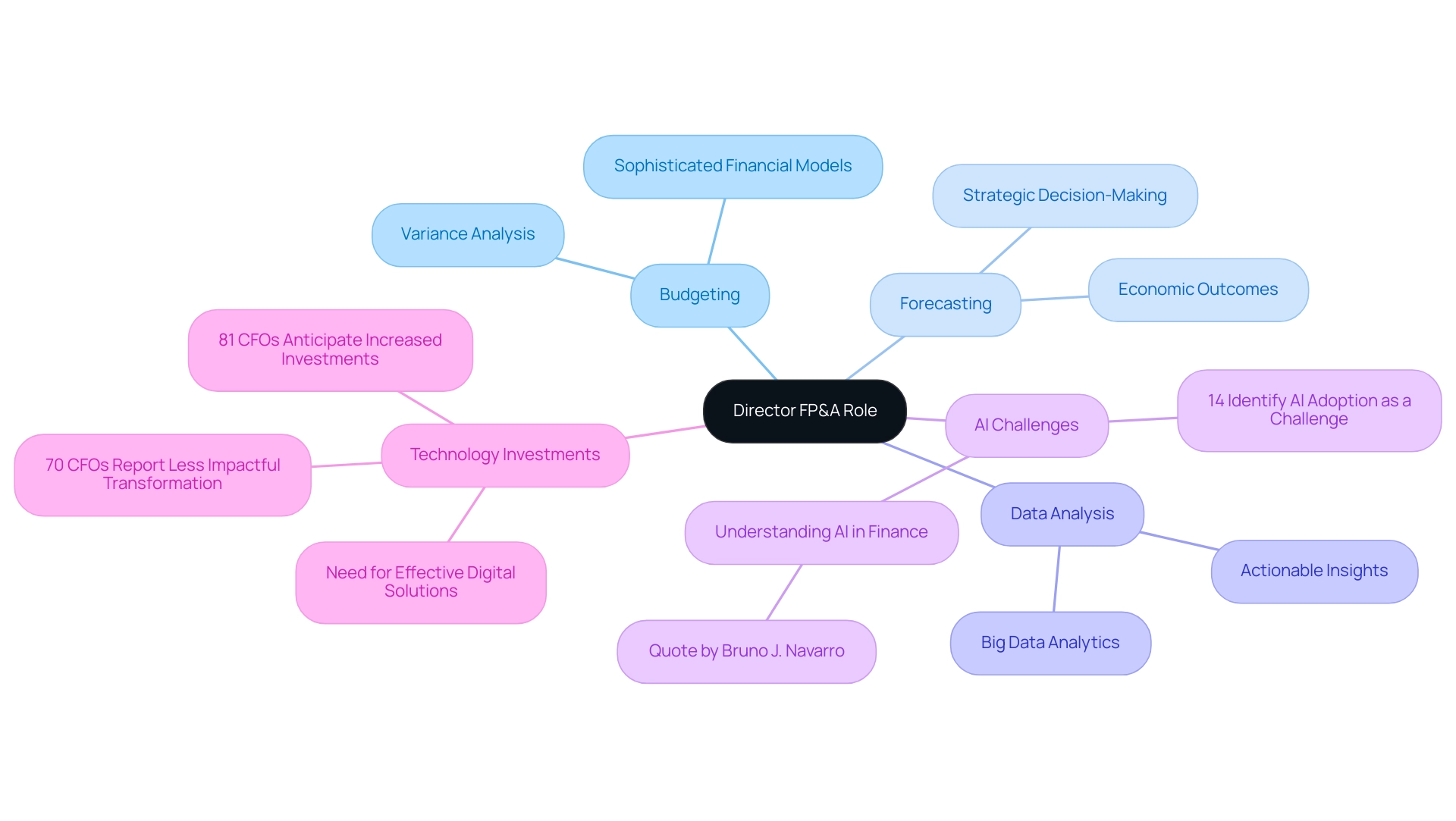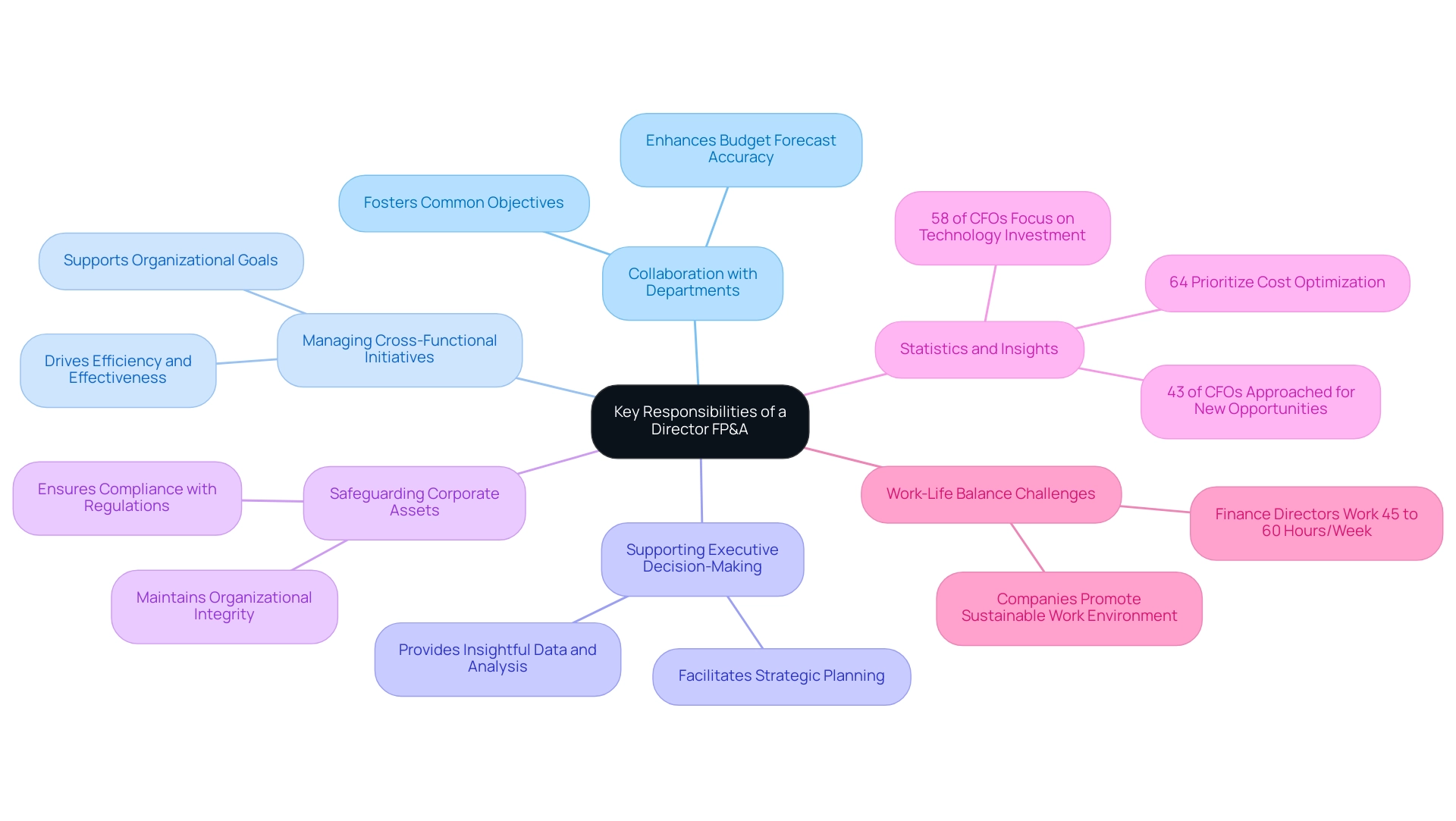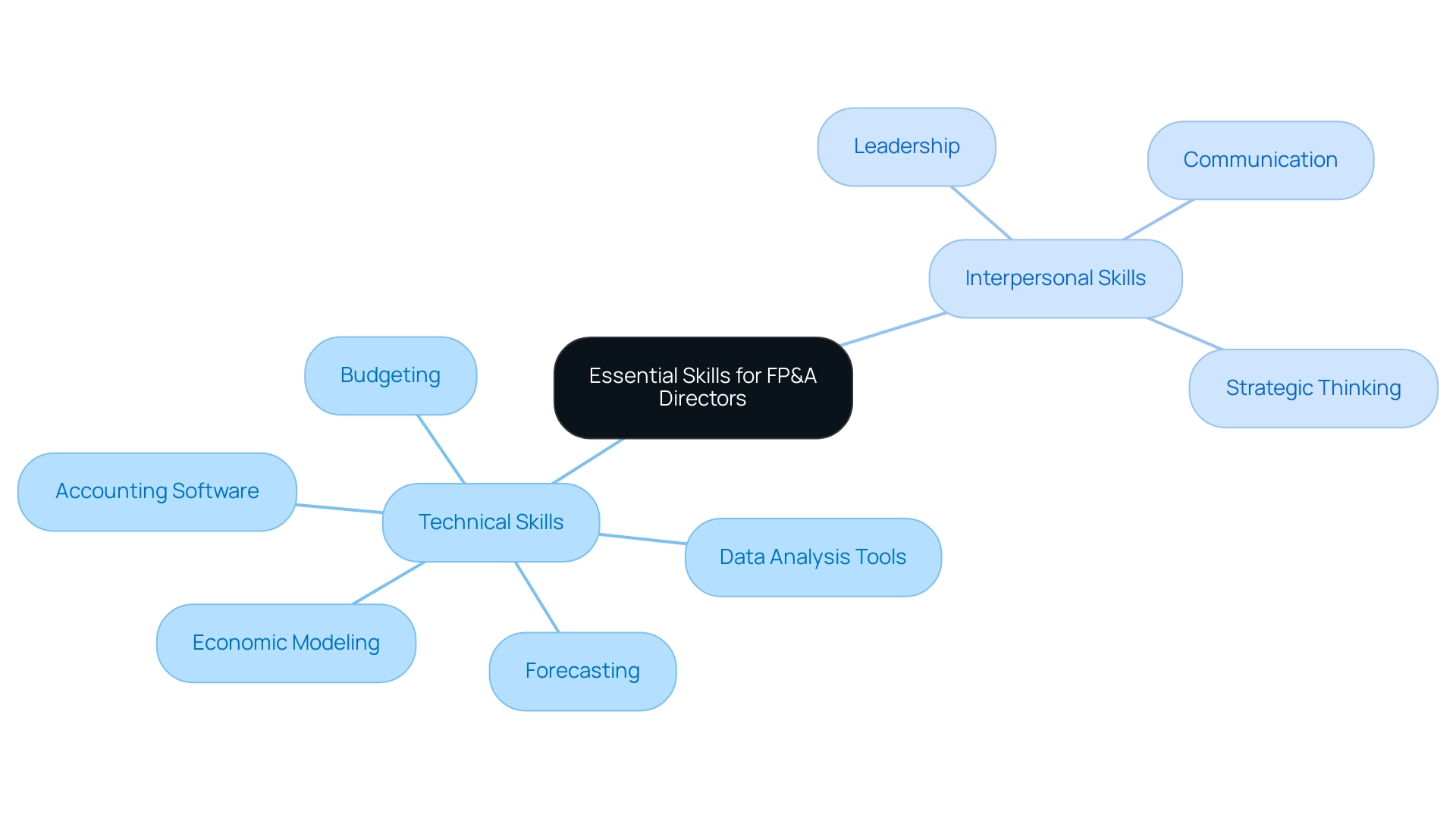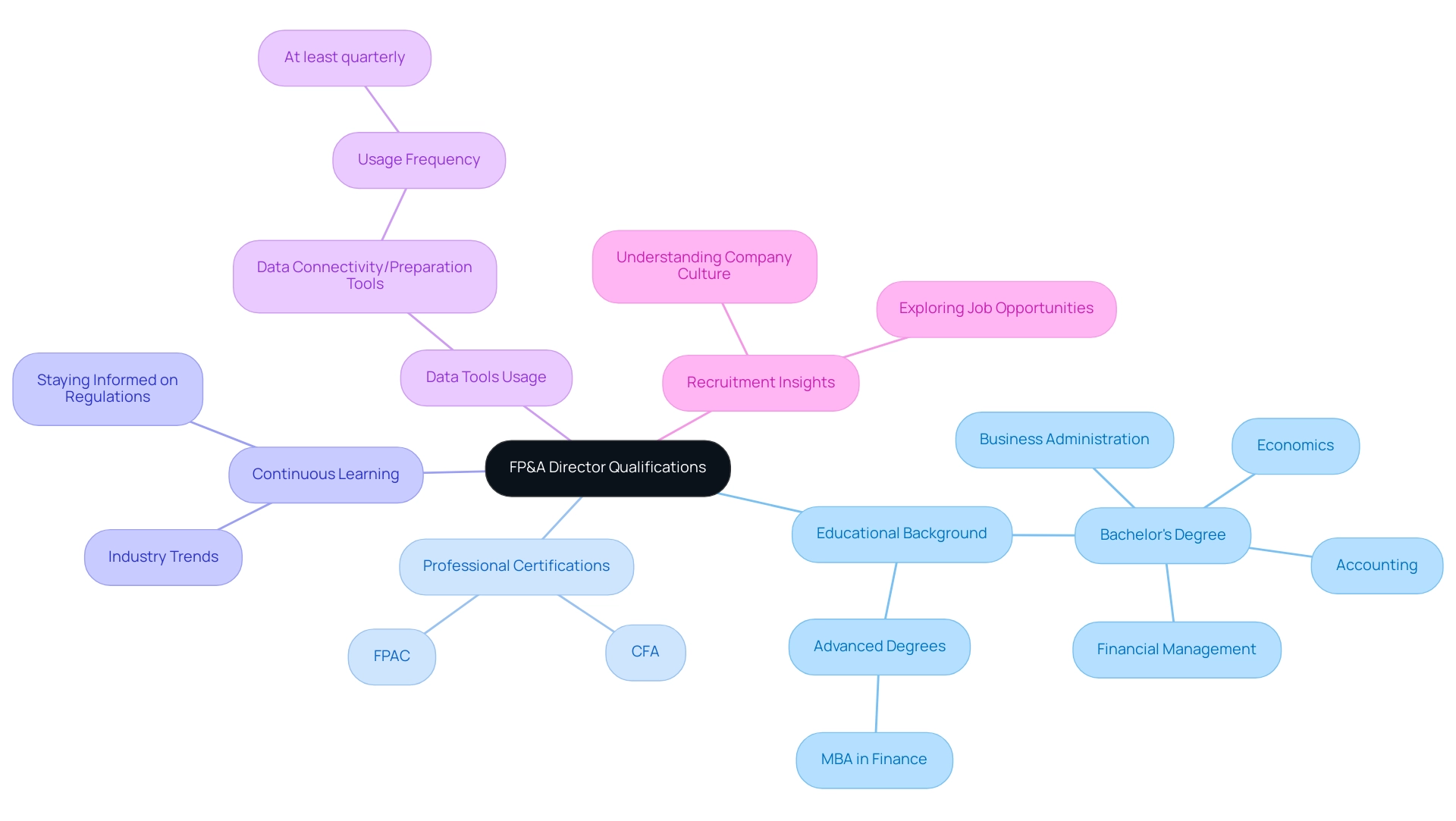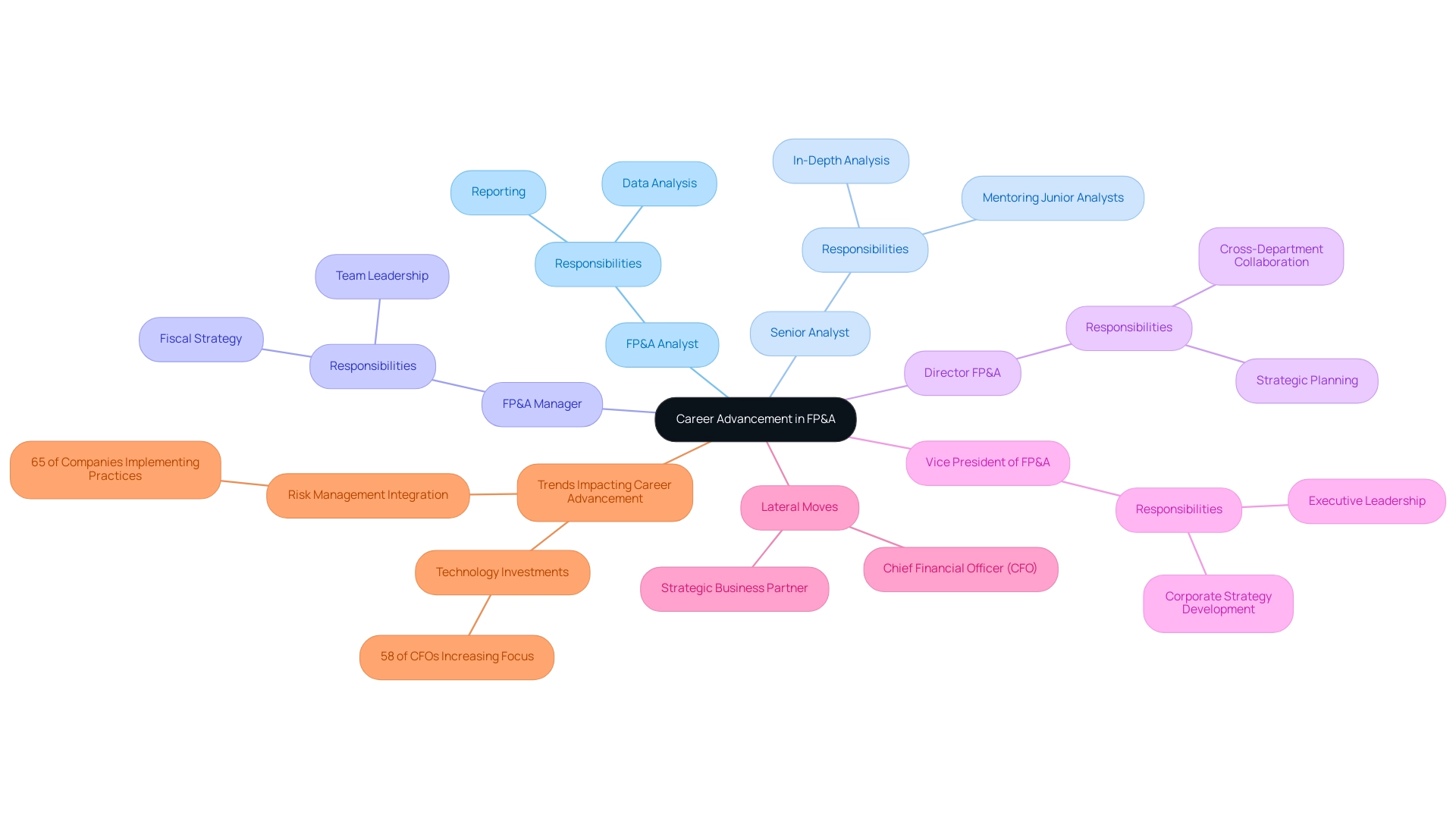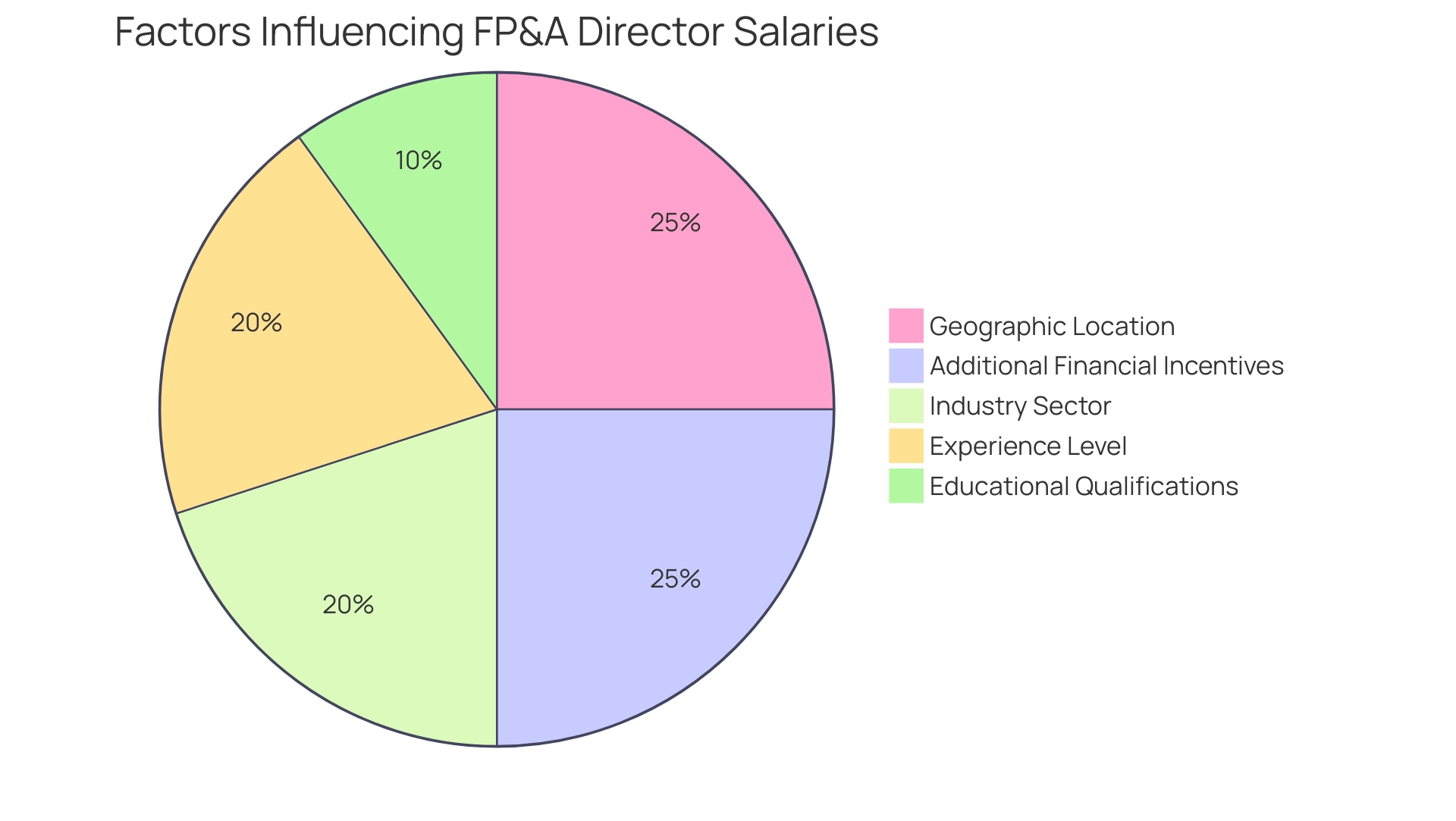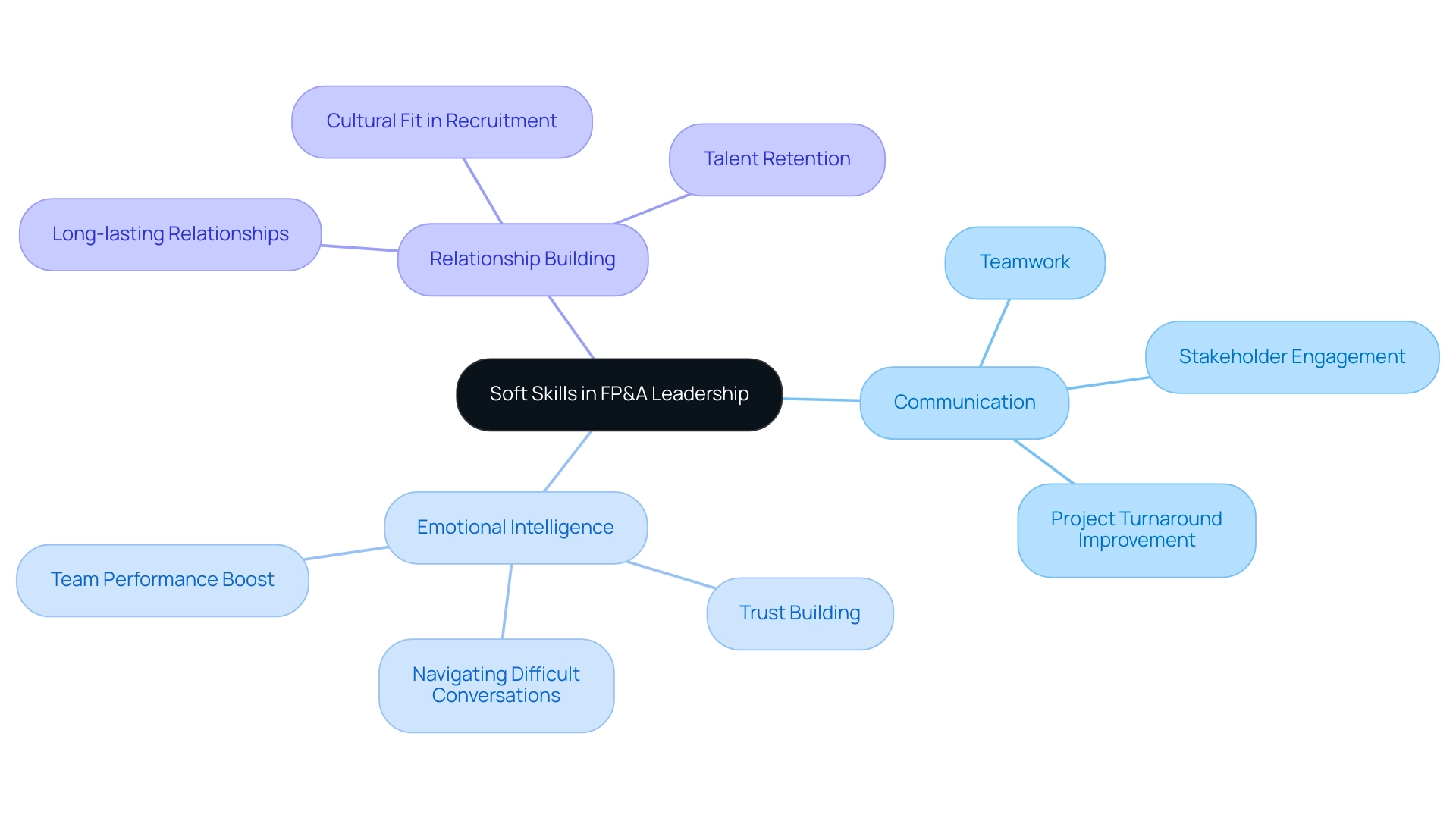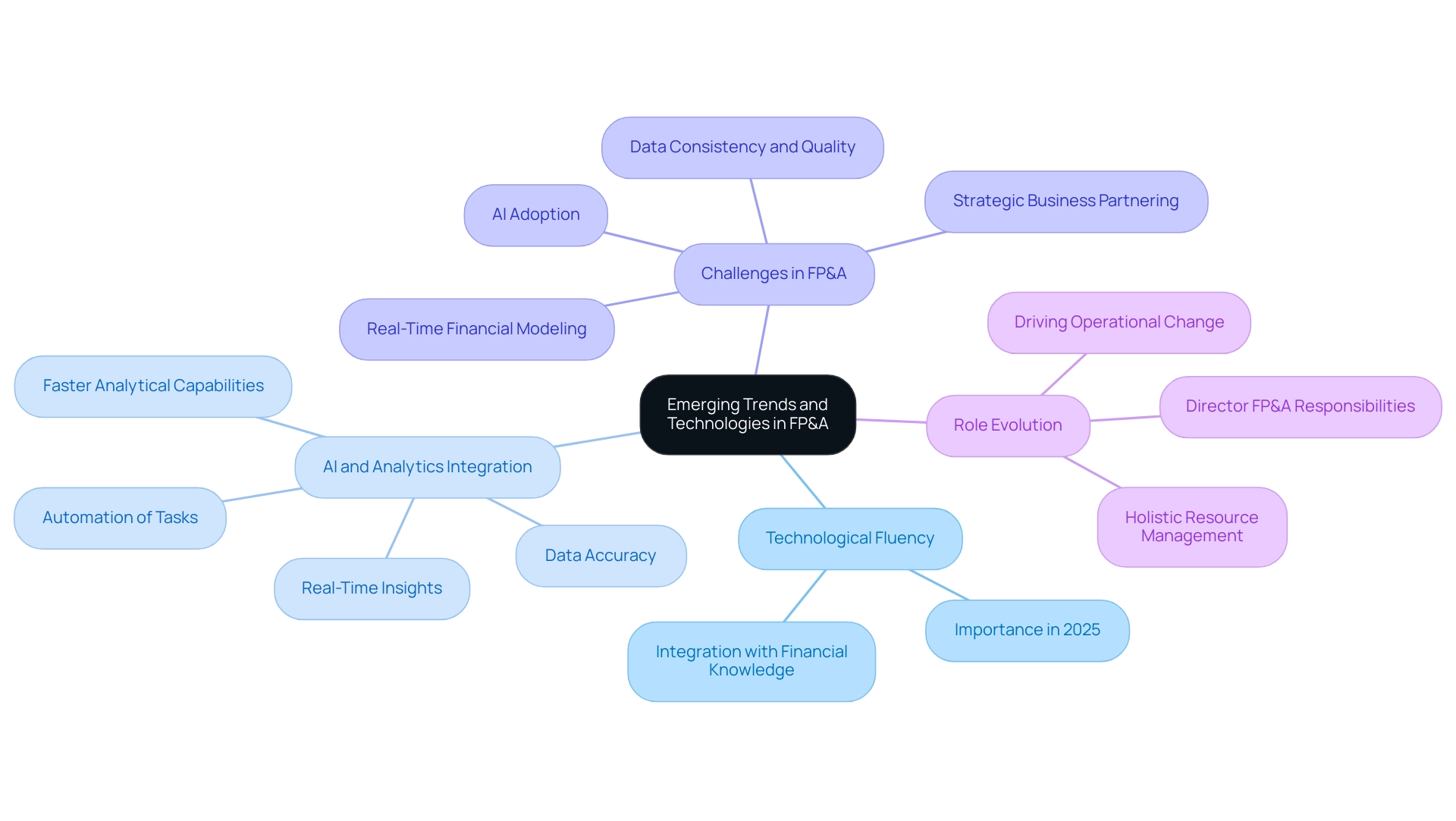Overview
The role of a Director of Financial Planning and Analysis (FP&A) is vital for effective budgeting, forecasting, and strategic decision-making within organizations. This importance intensifies as companies navigate the complexities of technological advancements and economic challenges. Notably, the integration of AI and advanced analytics enhances operational efficiency, positioning FP&A as a cornerstone of enterprise strategy. This evolution underscores the necessity for aspiring leaders to possess both technical proficiency and strong interpersonal skills.
How can organizations leverage this pivotal role to drive success? It’s essential to recognize that the future of FP&A is not just about numbers; it’s about strategic influence and leadership.
Key Highlights:
- The Director FP&A is essential for budgeting, forecasting, and strategic decision-making, optimizing resource allocation.
- AI adoption poses challenges but also offers opportunities for FP&A to become a central component of enterprise strategy.
- Effective FP&A practices improve organizational agility and economic outcomes, making the role increasingly vital in 2025.
- Key responsibilities include collaboration across departments, managing initiatives for efficiency, and supporting executive decision-making.
- A growing emphasis on technology investment and cost optimization is evident, with 58% of CFOs focusing on these areas.
- Soft skills like communication, emotional intelligence, and relationship-building are crucial for effective FP&A leadership.
- Aspiring FP&A directors should pursue advanced degrees and certifications to enhance career prospects in a competitive field.
- The average salary for a Director FP&A ranges from $145,000 to $200,000, influenced by factors like location and industry.
- Career advancement opportunities in FP&A include roles from Analyst to VP, emphasizing continuous professional development.
- Emerging technologies like AI and advanced analytics are transforming FP&A practices, necessitating a blend of technical and interpersonal skills.
Introduction
In the dynamic world of finance, the role of Financial Planning and Analysis (FP&A) is evolving rapidly, emerging as a cornerstone for organizations striving to optimize their financial strategies.
Businesses are increasingly pressured to adapt to technological advancements and market fluctuations. Consequently, FP&A teams are stepping into the spotlight, armed with sophisticated tools and insights that drive informed decision-making.
With the integration of artificial intelligence and big data analytics, the landscape of FP&A is not only transforming but also reshaping the skill set required for its leaders.
This article delves into the essential responsibilities, skills, and career pathways for aspiring FP&A Directors, while also exploring the emerging trends that are redefining the future of financial planning and analysis.
What is Financial Planning and Analysis (FP&A)?
The director FP&A plays a pivotal role in Planning and Analysis (FP&A), serving as a cornerstone within organizations by concentrating on budgeting, forecasting, and the meticulous examination of data to bolster strategic decision-making. In 2025, director FP&A teams are increasingly recognized for their vital role in optimizing resource allocation, ensuring that organizations not only meet but exceed their objectives. This entails the development of sophisticated financial models, thorough variance analysis between budgeted and actual performance, and the provision of actionable insights that empower executive leadership to make informed decisions.
Current trends indicate a significant shift in the FP&A landscape, with 14% of professionals in the field identifying AI adoption as a major challenge for director FP&A roles. However, financial leaders, in their capacity as director FP&A, are presented with a unique opportunity to transform FP&A into a central component of enterprise strategy by prioritizing upskilling, securing leadership buy-in, and leveraging big data analytics. As organizations navigate this transformation, the significance of the director FP&A becomes even more pronounced, with 81% of CFOs anticipating increased investments in technology to enhance their financial operations.
As Bruno J. Navarro states, “But to reap the benefits, organizations must understand the current state of AI in finance.”
Moreover, the impact of the director FP&A on strategic decision-making cannot be overstated. Effective FP&A practices, guided by a director FP&A, not only facilitate better economic outcomes but also drive organizational agility and responsiveness in a rapidly changing market. Participation in initiatives like The State of FP&A 2025 Survey will provide valuable insights into the current and future state of FP&A, enabling organizations to benchmark their practices against industry standards and understand the evolving landscape.
As companies continue to evolve, successful implementations of the director FP&A functions are characterized by a commitment to best practices, including the integration of advanced financial tools and a focus on data-driven decision-making. Despite the availability of sophisticated software, many accounting teams still rely heavily on spreadsheets and manual data entry, underscoring the critical need for effective digital solutions. In fact, 70% of CFOs report that their finance transformation efforts have been less impactful than anticipated, highlighting the necessity for organizations to embrace innovative strategies from the director FP&A to remain competitive in 2025.
Key Responsibilities of a Director FP&A
The role of the Director of FP&A is pivotal in guiding an organization’s planning processes. This position encompasses a range of critical responsibilities, including the development of budgets, forecasting future economic performance, and conducting thorough analyses. In 2025, effective planning oversight by the Director of FP&A is increasingly characterized by an ability to adapt to evolving market conditions and organizational needs.
Key responsibilities of a Director of FP&A include:
- Collaborating with various departments to ensure strategies align with organizational goals.
- Managing cross-functional initiatives that drive efficiency and effectiveness across the company.
- Supporting executive decision-making by providing insightful data and analysis.
- Safeguarding corporate assets and ensuring compliance with regulations, which is essential in maintaining organizational integrity.
As the management landscape evolves, the average responsibilities of a Director of FP&A in 2025 reflect a growing emphasis on collaboration. Recent statistics reveal that 58% of CFOs are dedicating more time to technology investment and implementation, underscoring the increasing importance of integrating advanced monetary tools into planning processes. Moreover, cost optimization is a priority for 64% of CFOs, highlighting the monetary priorities organizations are focusing on this year.
Furthermore, 43% of CFOs report being approached for new opportunities more frequently, emphasizing the competitive nature of leadership positions in finance. Insights from finance leaders reveal that the function of the Director of FP&A is crucial in fostering collaboration between departments. This collaboration not only enhances the accuracy of budget forecasts but also ensures that all teams are working towards common objectives. Case studies from successful companies illustrate how effective FP&A directors have implemented strategic planning initiatives that promote work-life balance, even amidst the demanding nature of the position, which often requires Finance Directors to work between 45 to 60 hours per week.
Many organizations have acknowledged the significance of work-life balance and have promoted strategic planning to minimize excessive work hours, fostering a sustainable work atmosphere.
In summary, the Director of FP&A is not merely a steward of resources but also a strategic ally within the organization, enhancing performance and ensuring that the company is well-positioned to achieve its objectives in a dynamic business landscape. Boutique Recruiting’s track record of success and numerous satisfied clients further emphasize the importance of effective recruitment in filling the Director of FP&A position, ensuring that organizations have the right talent to navigate these challenges. By leveraging Boutique Recruiting’s expertise in sourcing high-quality candidates for finance positions, organizations can significantly improve their chances of discovering the perfect Director of FP&A to guide their monetary strategies.
Essential Skills for Aspiring FP&A Directors
Aspiring directors in FP&A must cultivate a robust blend of technical and interpersonal abilities to excel in their roles. On the technical side, advanced economic modeling, budgeting, and forecasting represent foundational competencies. Expertise in data analysis tools and accounting software is essential, facilitating effective management of monetary data and insights.
However, the importance of interpersonal abilities cannot be overstated. Leadership, communication, and strategic thinking are vital for a director in FP&A to foster collaboration across departments and influence key decision-making processes. In fact, a recent survey revealed that 57% of finance leaders consider enhancing the existing FP&A workforce crucial for successful finance transformation. This underscores the growing acknowledgment of interpersonal abilities in finance roles.
Moreover, Chris Lowry, a Fractional CFO, emphasizes that aligning FP&A with broader company goals transcends mere numerical analysis; it involves paving the way for sustainable growth and success. This perspective highlights the necessity for FP&A leaders to not only possess technical expertise but also to engage effectively with their teams and stakeholders. The case study titled ‘Aligning FP&A with Company Goals’ illustrates this point, showing that successful directors in FP&A leverage both technical and interpersonal abilities to enhance teamwork and continuously monitor financial performance against strategic objectives.
In 2025, the significance of interpersonal abilities in financial planning and analysis leadership is further validated by case studies from leading firms, demonstrating that successful directors in FP&A leverage these attributes to enhance teamwork and continuously monitor financial performance against strategic objectives. By developing both technical and interpersonal abilities, aspiring directors in FP&A can position themselves as invaluable assets to their organizations, driving long-term success and alignment with corporate objectives. Boutique Recruiting’s impressive track record and reputation as a trusted recruiting partner further emphasize the value of these skills in the competitive landscape of leadership in the financial sector.
Educational Qualifications and Certifications for FP&A Directors
A director FP&A typically holds a bachelor’s degree in financial management, accounting, economics, or business administration, laying a solid foundation for their career. In 2025, statistics indicate that approximately 65% of FP&A Directors possess advanced degrees, with many opting for an MBA focused on finance to deepen their expertise. This trend underscores the competitive nature of the field, where advanced education is increasingly regarded as a critical asset.
Professional certifications significantly enhance career prospects for FP&A professionals. The Chartered Financial Analyst (CFA) designation and the Certified Corporate Financial Planning & Analysis Professional (FPAC) certification are among the most sought-after credentials in the industry. These certifications not only validate a candidate’s skills but also demonstrate a commitment to ongoing professional development, which is essential in a rapidly evolving economic landscape.
Expert opinions emphasize the importance of continuous learning and staying informed about regulations and industry trends. As the economic sector becomes more complex, the ability to adapt and apply new knowledge is crucial for success in the FP&A role. Additionally, 82% of FP&A professionals use data connectivity/preparation tools at least quarterly, highlighting the significance of these tools in effective financial planning and analysis. Moreover, case studies reveal that professionals who pursue relevant certifications often experience significant career advancement, with many reporting increased responsibilities and higher compensation.
Boutique Recruiting’s approach to recruitment illustrates the importance of understanding company culture and specific job requirements, which is vital when hiring for FP&A positions. Boutique Recruiting also emphasizes the importance of exploring multiple job opportunities, as this can significantly enhance career success in the financial sector.
In summary, aspiring directors in FP&A should prioritize obtaining both a solid educational background and relevant certifications. This combination not only enhances their qualifications but also positions them favorably in a competitive job market, where 54% of finance professionals report that finding a new job is relatively easy or very easy. By investing in their education and professional development, and by leveraging the tailored recruitment solutions provided by Boutique Recruiting, they can significantly enhance their career paths in planning and analysis.
Career Advancement Opportunities in FP&A
Career advancement in Financial Planning and Analysis (FP&A) typically follows a well-defined trajectory, beginning with entry-level positions such as FP&A Analyst. As professionals gain experience and expertise, they can progress to roles like:
- Senior Analyst
- FP&A Manager
- Director FP&A
- Vice President of FP&A
Each of these positions entails increased responsibilities, focusing on fiscal strategy, in-depth analysis, and leadership within the organization.
Moreover, FP&A professionals often have the opportunity to transition into other finance-related roles, including:
- Chief Financial Officer (CFO)
- Strategic business partner positions
This versatility is crucial in today’s dynamic business environment, where 58% of CFOs report spending more time on technology investments and implementations compared to the previous year. Such a trend indicates a shift towards integrating advanced financial technologies into strategic planning, significantly influencing career advancement opportunities within the field.
The pathway to becoming a Director FP&A is not solely about climbing the corporate ladder; it also emphasizes continuous professional development. Investing in expertise, education, and certifications is essential for unlocking the full potential of this promising field. As Mohamed Yousuf, Marketing Manager at Pivotal, aptly states, “Invest in your abilities, education, and certifications to unlock the full potential of this promising field.”
Statistics reveal that over 65% of companies have incorporated risk management practices within FP&A, underscoring the essential role FP&A teams play in identifying, analyzing, and mitigating financial risks, particularly in uncertain business environments. This integration not only enhances the strategic value of FP&A but also opens up further career advancement opportunities. Additionally, collaborating with specialized recruiters like Boutique Recruiting can help identify high-potential candidates who may not be actively job hunting, further supporting professionals in their career progression.
For those aspiring to ascend the FP&A career ladder, understanding the typical career path is vital. The average time to advance from an FP&A Analyst to a Director FP&A can vary; however, with dedication and the right opportunities, professionals can expect to witness significant growth in their careers. Successful transitions from FP&A Analyst to Director FP&A are often characterized by a blend of strategic thinking, leadership abilities, and a profound understanding of the business landscape, making these positions highly sought after in the finance sector.
Furthermore, exploring multiple job offers can significantly impact career success, as it allows professionals to evaluate their options and find the best fit for their skills and aspirations. Boutique Recruiting’s tailored recruitment solutions can assist candidates in navigating these opportunities effectively.
Understanding FP&A Director Salaries and Compensation
In 2025, the average salary for a director FP&A in the United States is projected to fall between $145,000 and $200,000 annually. This range is influenced by several key factors, including geographic location, industry sector, and the individual’s experience level. For instance, director FP&A positions in high-demand industries or metropolitan areas often command higher salaries due to the competitive nature of the job market. Moreover, compensation packages for director FP&A frequently extend beyond base salary.
Many professionals in this role receive additional financial incentives such as performance bonuses, stock options, and other benefits, which can significantly boost total earnings. In fact, the average salary for a Vice President of FP&A is reported to be around $250,813, highlighting the potential for salary growth as professionals advance in their careers. Current trends indicate that the director FP&A can enhance their earning potential by changing employers, pursuing advanced degrees, or taking on managerial responsibilities over junior directors. Notably, 65.3% of director FP&A hold a Master’s Degree, while 32.5% have a Bachelor’s Degree, indicating the educational qualifications that can influence salary prospects.
This adaptability in career progression is essential in a landscape where 82% of FP&A professionals utilize data connectivity and preparation tools at least quarterly, underscoring the importance of data-driven decision-making in the director FP&A position. As the demand for skilled director FP&A leaders continues to rise, understanding the nuances of salary structures across various industries becomes increasingly important. For example, compensation packages may vary significantly between sectors such as technology, healthcare, and finance, reflecting the unique challenges and expectations within each field. Boutique Recruiting differentiates itself by focusing on building lasting relationships and understanding company culture, which is crucial for hiring effective director FP&A.
Additionally, exploring multiple job offers can significantly impact career success, and Boutique Recruiting is well-positioned to assist candidates in navigating these opportunities. By staying informed about these trends and utilizing their expertise effectively, aspiring director FP&A can position themselves for lucrative opportunities in this dynamic market.
The Importance of Soft Skills in FP&A Leadership
In the realm of director FP&A leadership, technical expertise alone is insufficient; soft skills such as communication, emotional intelligence, and relationship-building are equally crucial. These competencies enable the director FP&A to express complex economic concepts to non-economic stakeholders, facilitating a clearer understanding of monetary implications across the organization. Effective communication promotes teamwork among departments, ensuring that economic insights are incorporated into wider strategic discussions.
As the role of the director FP&A evolves to become more essential to strategic decision-making, the capacity to influence and engage others becomes crucial. For instance, leaders who exhibit high emotional intelligence can navigate challenging conversations and build trust within their teams, which is essential for fostering a positive work environment. A recent study emphasized that organizations with emotionally intelligent leaders experience a 20% boost in team performance, highlighting the concrete advantages of these abilities.
Moreover, case studies show that FP&A teams, especially those led by a director FP&A with strong interpersonal traits, are more effective at leading initiatives that align monetary goals with organizational objectives. A prominent financial company announced that improving communication abilities within their FP&A team resulted in a 30% enhancement in project turnaround times, showcasing the direct effect of interpersonal competencies on operational efficiency.
Statistics further highlight the significance of interpersonal abilities in leadership positions. Despite holding 85% of executive positions, only 38% of the labor force comprises white males, indicating a growing diversity in leadership that emphasizes the need for emotional intelligence and adaptability. Expert viewpoints support this idea, with industry leaders observing that 44% of executives contemplating a career change mention a lack of emotional connection in their current positions as a significant factor.
This aligns with the approach of Boutique Recruiting, which emphasizes building lasting relationships and understanding company culture to ensure successful placements. By prioritizing emotional intelligence, Boutique Recruiting enhances the retention of talent within director FP&A roles, demonstrating the significance of these abilities in the recruitment process.
In addition to these soft attributes, Boutique Recruiting specializes in custom searches for technical positions such as Chief Technology Officer, Engineer, and Systems Administrator, ensuring that candidates not only possess the necessary technical expertise but also the interpersonal qualities required for effective collaboration. This customized method enables Boutique Recruiting to match candidates with the particular requirements of diverse sectors, improving the overall efficiency of placements.
In summary, the incorporation of interpersonal abilities into the role of director FP&A leadership is not just advantageous but crucial for successful team dynamics and organizational achievement. As the environment of monetary management continues to develop, the focus on these competencies will only grow, establishing them as a crucial priority for those aspiring to be director FP&A leaders. Boutique Recruiting’s impressive track record of success and numerous satisfied clients further illustrate that prioritizing soft skills can lead to enhanced effectiveness in leadership positions, both in recruitment and finance.
Emerging Trends and Technologies in FP&A
The role of the director of FP&A is paramount as the FP&A landscape experiences a transformative shift, propelled by the integration of artificial intelligence (AI) and advanced analytics. These cutting-edge technologies are revolutionizing traditional practices by automating routine tasks, thereby not only enhancing efficiency but also improving data accuracy. Consequently, director FP&A teams are equipped to deliver real-time insights that facilitate agile decision-making—a critical capability in today’s fast-paced business environment.
In 2025, the importance of technological fluency will rival that of conventional economic knowledge in director FP&A roles, underscoring the growing demand for professionals adept at navigating both fiscal and technological realms. This shift is corroborated by the fact that 58% of CFOs are allocating more time to technology investment and implementation compared to the previous year, signaling a strategic pivot towards the integration of technology into operational processes. As Barbara Larson, CFO, aptly notes, “CFOs today are required to provide more than just monetary insights. They’re required to provide insights that can drive operational change and guide business strategy, ultimately delivering long-term value to stakeholders.”
Furthermore, the role of the director FP&A in merging budgetary planning with operational and strategic planning is increasingly vital. Directors and other professionals are now expected to embrace a holistic approach to resource management, aligning insights with broader business strategies. This evolution necessitates a deeper understanding of data consistency and quality, as highlighted in recent discussions among FP&A teams, where challenges such as strategic business partnering and real-time budgeting modeling were identified.
The most pressing challenge recognized was data consistency and quality, which significantly affects the management and alignment of data.
As organizations adopt AI, the implications for the responsibilities of the director FP&A in financial planning and analysis are profound. For example, AI adoption is enabling faster analytical capabilities and a more seamless integration of FP&A into decision-making processes. This trend not only enhances the role of FP&A professionals but also positions the director FP&A as a pivotal contributor to driving operational change and guiding business strategy, ultimately delivering long-term value to stakeholders.
Conclusion
The evolving landscape of Financial Planning and Analysis (FP&A) underscores its critical role in driving informed decision-making within organizations. As businesses navigate the complexities of technological advancements and market fluctuations, FP&A teams are emerging as strategic partners, equipped with sophisticated tools and insights that optimize financial strategies. The responsibilities of an FP&A Director have expanded, emphasizing collaboration, data-driven decision-making, and the integration of advanced financial technologies.
To excel in this dynamic environment, aspiring FP&A Directors must cultivate a blend of technical and soft skills. The importance of leadership, communication, and emotional intelligence cannot be overstated, as these competencies enable effective collaboration across departments and enhance the overall impact of financial insights on organizational objectives. Furthermore, educational qualifications and professional certifications serve as essential assets in advancing one’s career, positioning individuals favorably in a competitive job market.
As the demand for skilled FP&A leaders continues to rise, understanding emerging trends such as AI integration and the importance of data consistency will be vital for success. With the potential for lucrative compensation and career advancement opportunities, professionals in FP&A are well-positioned to influence strategic outcomes and drive business value.
In summary, the future of FP&A is bright, characterized by a shift towards technology fluency and strategic alignment. By prioritizing continuous learning, embracing innovative practices, and leveraging both technical and interpersonal skills, aspiring FP&A Directors can significantly enhance their contributions to their organizations and navigate the complexities of this evolving field.
Frequently Asked Questions
What is the primary role of a Director of FP&A?
The Director of FP&A plays a crucial role in planning and analysis within organizations, focusing on budgeting, forecasting, and data examination to support strategic decision-making.
How are Director FP&A teams expected to evolve by 2025?
By 2025, Director FP&A teams are increasingly recognized for optimizing resource allocation and are expected to develop sophisticated financial models, conduct variance analysis, and provide actionable insights for executive leadership.
What challenges do professionals in FP&A face regarding AI adoption?
Current trends indicate that 14% of FP&A professionals identify AI adoption as a significant challenge for Director FP&A roles.
How can financial leaders transform FP&A into a strategic component of enterprise strategy?
Financial leaders can transform FP&A by prioritizing upskilling, securing leadership buy-in, and leveraging big data analytics.
What do CFOs anticipate regarding investments in technology for FP&A?
81% of CFOs anticipate increased investments in technology to enhance financial operations.
What impact does the Director of FP&A have on strategic decision-making?
The Director of FP&A significantly impacts strategic decision-making by facilitating better economic outcomes and driving organizational agility in a rapidly changing market.
How can organizations benchmark their FP&A practices?
Organizations can benchmark their FP&A practices by participating in initiatives like The State of FP&A 2025 Survey, which provides insights into current and future FP&A trends.
What are the key responsibilities of a Director of FP&A?
Key responsibilities include collaborating with departments to align strategies, managing cross-functional initiatives, supporting executive decision-making with data analysis, and ensuring compliance with regulations.
What emphasis is placed on technology investment by CFOs in 2025?
58% of CFOs are dedicating more time to technology investment and implementation, highlighting the importance of integrating advanced financial tools into planning processes.
How do successful FP&A directors contribute to organizational collaboration?
Successful FP&A directors foster collaboration between departments, enhancing the accuracy of budget forecasts and ensuring alignment towards common objectives.
What is the average work schedule for Finance Directors?
Finance Directors typically work between 45 to 60 hours per week, although many organizations are promoting work-life balance to minimize excessive work hours.
How does Boutique Recruiting support organizations in filling the Director of FP&A position?
Boutique Recruiting helps organizations find high-quality candidates for finance positions, ensuring they have the right talent to navigate the challenges of the Director of FP&A role.
